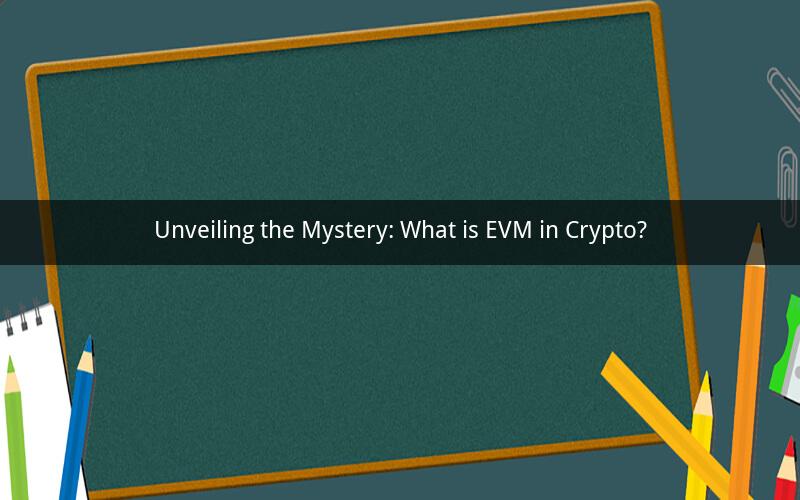
Introduction:
In the rapidly evolving world of cryptocurrency, understanding the underlying technologies is crucial. One such technology that plays a pivotal role in the crypto ecosystem is the Ethereum Virtual Machine (EVM). This article delves into the intricacies of EVM, its significance in the crypto space, and its impact on the future of blockchain technology.
1. What is EVM?
The Ethereum Virtual Machine (EVM) is a decentralized, Turing-complete virtual machine that executes smart contracts on the Ethereum blockchain. It serves as the runtime environment for smart contracts, enabling developers to build decentralized applications (DApps) and decentralized finance (DeFi) platforms.
2. How does EVM work?
At its core, EVM operates on a stack-based architecture. It consists of a set of accounts, each with a balance, code, and storage. When a transaction is executed, the EVM uses the account's code to determine the next operation to perform. This process continues until the transaction is completed or the gas limit is reached.
The EVM operates on a series of steps, including:
a. Creation of a new state: When a transaction is received, the EVM creates a new state for the transaction, ensuring that the execution of the smart contract is isolated from other transactions.
b. Execution of the contract: The EVM uses the account's code to execute the smart contract. This involves reading and writing data from the storage and interacting with other contracts.
c. Gas consumption: EVM uses gas to measure the computational cost of executing a transaction. Each operation performed by the EVM consumes a certain amount of gas, and the transaction must have enough gas to cover the execution cost.
3. The significance of EVM in crypto
The Ethereum Virtual Machine has several crucial roles in the crypto space:
a. Smart contracts: EVM allows developers to create and deploy smart contracts on the Ethereum blockchain. These contracts are self-executing agreements that automatically enforce and execute the terms of the agreement, eliminating the need for intermediaries.
b. Decentralized applications: EVM enables the development of DApps, which are applications that run on a decentralized network. These applications can range from decentralized exchanges to decentralized identity solutions.
c. Decentralized finance: EVM has played a significant role in the growth of DeFi, enabling the development of decentralized financial services such as lending, borrowing, and trading platforms.
4. The impact of EVM on the future of blockchain technology
The Ethereum Virtual Machine has several implications for the future of blockchain technology:
a. Scalability: As the crypto space continues to grow, scalability becomes a crucial factor. EVM's ability to execute smart contracts efficiently makes it a key component in addressing scalability challenges.
b. Interoperability: EVM has the potential to enable interoperability between different blockchain networks. This can lead to a more interconnected and efficient crypto ecosystem.
c. Innovation: The EVM has paved the way for innovation in the crypto space, with developers continuously exploring new use cases and applications for smart contracts.
5. Common questions about EVM in crypto
Question 1: What is the difference between EVM and other blockchain platforms?
Answer: EVM is unique to the Ethereum blockchain and provides a specific set of features and capabilities for smart contract execution. Other blockchain platforms may have their own virtual machines or alternative mechanisms for executing smart contracts.
Question 2: Can EVM be used on other blockchains?
Answer: While EVM is primarily associated with Ethereum, there have been efforts to port the EVM to other blockchains. This can enable interoperability and portability of smart contracts across different networks.
Question 3: How does EVM ensure security?
Answer: EVM operates on a decentralized network, making it resistant to single points of failure. Additionally, smart contracts executed on the EVM are immutable, ensuring that the terms of the agreement cannot be altered or tampered with.
Question 4: Can EVM be used for centralized applications?
Answer: While EVM is primarily designed for decentralized applications, it can be used for centralized applications as well. However, the decentralized nature of EVM is most beneficial for applications that require trustless execution and transparency.
Question 5: What are the limitations of EVM?
Answer: One of the limitations of EVM is its gas consumption, which can be a barrier for certain applications. Additionally, the complexity of smart contracts and the potential for bugs can pose challenges to developers.
Conclusion:
The Ethereum Virtual Machine (EVM) is a crucial component of the crypto space, enabling the development of smart contracts, DApps, and DeFi platforms. As blockchain technology continues to evolve, EVM's role in driving innovation and scalability is set to grow. Understanding the workings and implications of EVM is essential for anyone involved in the crypto ecosystem.